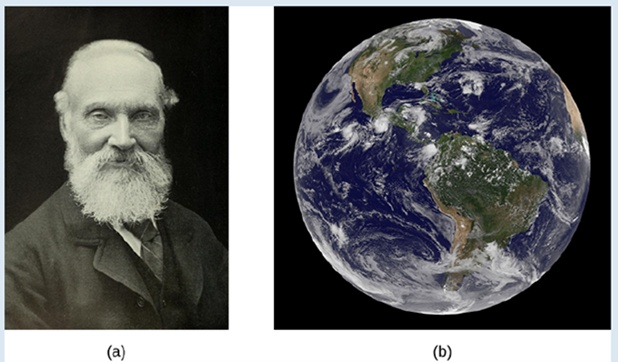
Concept explainers
Lord Kelvin and the Age of Earth
 Figure 4.25 (a) William Thomson (Lord Kelvin). 1824-1907, was a British physicist and electrical engineer. (b) Kelvin used the heat diffusion equation to estimate the age of Earth (credit: modification of work by NASA).
Figure 4.25 (a) William Thomson (Lord Kelvin). 1824-1907, was a British physicist and electrical engineer. (b) Kelvin used the heat diffusion equation to estimate the age of Earth (credit: modification of work by NASA).
During the late 1800s, the scientists of the new field of geology were coming to the conclusion the Earth must be “millions and millions” of years old. At about the same time. Charles Darwin had published his treatise on evolution.
Darwin’s view was that evolution needed many millions of years to take place, and he made a bold claim that the Weald chalk fields, where important fossils were found, were the result of 300 million years of erosion.
At that time, eminent physicist William Thomson (lord Kelvin) used an important partial differential equation, known as the heat diffusion equation, to estimate the age of Earth by determining how long it would take Earth to cool from molten rock to what we had at tha time. His conclusion was a range of 20 to 4(X) million years, but most likely about 5() million years. For many decades, the proclamations of this irrefutable icon of science did not sit well with geologists or with Darwin.
tJR ead Kelvin’s paper (http:Iiwww.openstaxcollege.orgIlI2O KelEarthAge) on estimating the age of the Earth.
Kelvin made reasonable assumptions based on what was known in his time, but he also made several assumptions that turned out to be wrong. One incorrect assumption was that Earth is solid and that the cooling was therefore via conduction only, hence justifying the use of the diffusion equation. But the most serious error was a forgivable one—omission of the fact that Earth contains radioactive elements that continually supply heat beneath Earth’s mantle. The discoveiy of radioactivity came near the end of Kelvin’s life and he acknowledged that his calculation would have to be modified.
Kelvin used the simple one-dimensional model applied only to Earth’s outer shell, and derived the age from gsaphs and the roughly known temperature gs-adietn near Earth’s surface. Let’s take a look at a more appropriate version of the diffusion equation in radial coordinates, which has the form
(4.23)
Here, T(r.t) is temperature as a function of r (measured from the center of Earth) and time i. K is the heat conductivity—for molten rock, in this case. ibe standard method of solving such a partial differential equation is by separation of variables, where we express the solution as the product of functions containing each variable separately. In this case, we would write the temperature as
Trending nowThis is a popular solution!

Chapter 4 Solutions
Calculus Volume 3
Additional Math Textbook Solutions
Thinking Mathematically (6th Edition)
Elementary Statistics: Picturing the World (7th Edition)
Elementary Statistics (13th Edition)
Precalculus
A First Course in Probability (10th Edition)
University Calculus: Early Transcendentals (4th Edition)
- A marketing agency wants to determine whether different advertising platforms generate significantly different levels of customer engagement. The agency measures the average number of daily clicks on ads for three platforms: Social Media, Search Engines, and Email Campaigns. The agency collects data on daily clicks for each platform over a 10-day period and wants to test whether there is a statistically significant difference in the mean number of daily clicks among these platforms. Conduct ANOVA test. You can provide your answer by inserting a text box and the answer must include: also please provide a step by on getting the answers in excel Null hypothesis, Alternative hypothesis, Show answer (output table/summary table), and Conclusion based on the P value.arrow_forwardA company found that the daily sales revenue of its flagship product follows a normal distribution with a mean of $4500 and a standard deviation of $450. The company defines a "high-sales day" that is, any day with sales exceeding $4800. please provide a step by step on how to get the answers Q: What percentage of days can the company expect to have "high-sales days" or sales greater than $4800? Q: What is the sales revenue threshold for the bottom 10% of days? (please note that 10% refers to the probability/area under bell curve towards the lower tail of bell curve) Provide answers in the yellow cellsarrow_forwardBusiness Discussarrow_forward
- Can you help explain what I did based on partial fractions decomposition?arrow_forwardFind the surface area of the regular pyramid. yd2arrow_forwardSuppose that a particle moves along a straight line with velocity v (t) = 62t, where 0 < t <3 (v(t) in meters per second, t in seconds). Find the displacement d (t) at time t and the displacement up to t = 3. d(t) ds = ["v (s) da = { The displacement up to t = 3 is d(3)- meters.arrow_forward
- Let f (x) = x², a 3, and b = = 4. Answer exactly. a. Find the average value fave of f between a and b. fave b. Find a point c where f (c) = fave. Enter only one of the possible values for c. c=arrow_forwardThe following data represent total ventilation measured in liters of air per minute per square meter of body area for two independent (and randomly chosen) samples. Analyze these data using the appropriate non-parametric hypothesis testarrow_forwardeach column represents before & after measurements on the same individual. Analyze with the appropriate non-parametric hypothesis test for a paired design.arrow_forward
- Algebra & Trigonometry with Analytic GeometryAlgebraISBN:9781133382119Author:SwokowskiPublisher:Cengage
 Linear Algebra: A Modern IntroductionAlgebraISBN:9781285463247Author:David PoolePublisher:Cengage Learning
Linear Algebra: A Modern IntroductionAlgebraISBN:9781285463247Author:David PoolePublisher:Cengage Learning Trigonometry (MindTap Course List)TrigonometryISBN:9781337278461Author:Ron LarsonPublisher:Cengage Learning
Trigonometry (MindTap Course List)TrigonometryISBN:9781337278461Author:Ron LarsonPublisher:Cengage Learning


